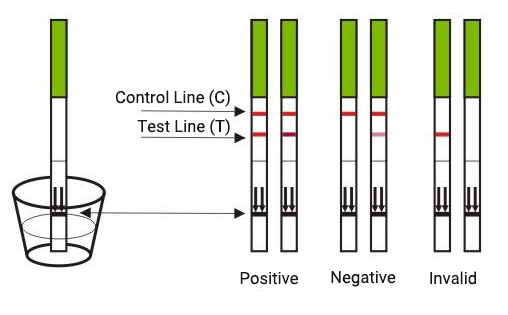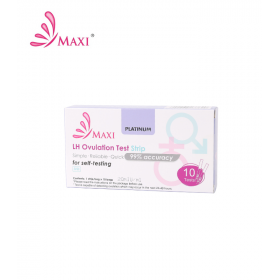Product Categories
Most popular
Maxi® High Sensitivity Ovulation Test (20miU/ml)
Semi-quantitative membrane test for the in-vitro detection of LH (luteinizing hormone) in urine A one step, 5 minute test at room temperature for self-testing
Background
A woman’s body continuously produces a small amount of luteinizing hormone (LH). During the middle of the menstrual cycle, there is a sudden increase of this hormone followed by a rapid decline back to basal levels. While the maximal LH concentration before and after the surge is < 20 mIU/ml, LH levels from >30 to 100 mIU/ml are reached at peak times. This increase of the LH level, called LH surge, promotes the release of a mature egg from the ovary (ovulation). For most women, ovulation will occur within 24 - 36 hours after the first steep increase of the LH level. Immediately after the ovulation the egg is ready to be fertilised for a short time (appr. 12-24 hours). With Maxi® High Sensitivity Ovulation Test (20miU/ml), LH in urine will be determined for a time period of 5 days. In this time the test will detect if and when a LH surge occurs. The „most fertile days“ of the menstrual period start after this LH surge. As sperms are fertile for about 3 days (rarely even 6 days) after sexual intercourse the fertile period can be limited to about 3-5 days before and 2 days after the surge.
Principle
The Maxi® High Sensitivity Ovulation Test (20miU/ml) is a rapid test for the determination of human luteinizing Hormone (LH) in urine. When LH is present in the sample, it is bound by specific antibodies immobilised at the test region of the membrane. This complex is then made visible by binding of another gold-labelled antibody, resulting in a colored line. The intensity of the test result line depends on the amount of LH in the urine sample.
Starting Day of Testing
The starting day of testing depends on the length of the last normal menstrual cycles. The first day of bleeding of menstrual period is counted as day 1. The chart below demonstrates the correlation between starting day and the length of a typical menstrual cycle.
|
If the menstrual cycle is shorter or longer than in the chart above, a physician should be consulted for the recommended day to start testing. If your cycle is not regular it might be necessary to prolong the testing period.
-
Collection of samples
The urine samples should be collected at around the same time each day. Morning urine can be used for testing, but please note that LH might accumulate in the urine over the night thus the possibility of a false positive single test is a little increased. An excess uptake of liquid should be avoided at least 3 hours before sample taking (dilution of the urine). If necessary the sample can be stored in the refrigerator for up to 24 hours. Before testing the sample must be warmed to room temperature.
-
Test procedure
-
Open the pouch and remove the test strip.
- Whilst holding the test strip pointing downwards, place the strip into the urine sample for 10 seconds, making sure not to go past the MAX line.
- Remove the test strip from the urine sample and lay it on a clean, dry, flat surface.
- Wait for the results to show. Positive results may be observed as early as one minute after removal from the urine sample. However, to confirm a negative result, you should wait for the full 10 minutes. Do NOT read the results after 30 minutes.
-
-
Interpretation of results
Positive for LH surge: If two colour bands are visible, and the test line(T) is equal to or darker than the control line(C), you will probably ovulate within the next 24-48 hours. If you are trying to get pregnant, you should have intercourse frequently over the next 48 hours.
Negative for LH surge: Only one colour line appears on the control region, or the test line(T) appears but is lighter than the control line(C). This means there is no LH surge. You should continue daily testing.
Invalid: The control line(C) has not appeared after 5 minutes. You should repeat the test with a new unit.









